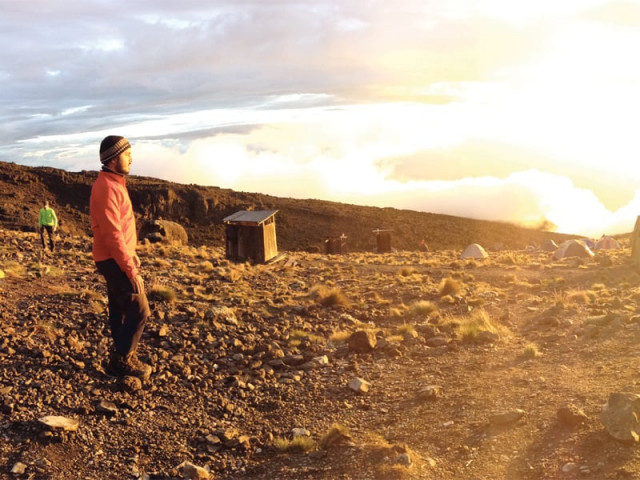I conquered Kilimanjaro
‘He who climbs upon the highest mountains laughs at all tragedies, real or imaginary,’ says Nietzsche.

‘He who climbs upon the highest mountains laughs at all tragedies, real or imaginary’ Nietzsche.
The idea took root one night in a state of exhilaration and insomnia. Dazed with excitement and filled with an iron-clad determination to accomplish my goal, I began my preliminary research on the internet. In the mid 1980s, a new challenge was formed, coveted by the world’s best mountaineers: The Seven Summits. These seven summits are the highest peaks in the seven continents. At the turn of the millennium, there were just a few hundred individuals who had made it to the list of successful climbers, but these numbers have now multiplied with the increase in technology and safety procedures. Scrolling through the lists of glorified summiteers from all over the world, I noticed something — none of them were from Pakistan. As much as I looked around on the web I couldn’t find any, not even failed attempts. By the time the sun rose, I was convinced I had found my calling.
After some painstaking planning, I found myself at the foot of Mount Kilimanjaro as part of an expedition of 35 people. Kilimanjaro, which can be traversed without mountain climbing gear, features several topographies including savannah, rainforest, moorlands, arctic desert and the snow-covered summit itself. Kilimanjaro is the smallest of the seven summits and the tallest mountain in all of continental Africa. Even though it is no joke to attempt scaling it, it is considered a ‘non-technical’ climb and it’s relatively easy compared to the other six summits.

We didn’t have much luck with the weather. Even though we were set to climb right at the end of the East African rainy season, it rained every day. The few times it stopped raining completely were our good days. Otherwise, our dinners would be eaten under the gloomy pitter patter of rain on the tents.
As it turned out, the natural path for the rainwater to flow down the mountain was also the easiest path for us to ascend. After making its way through the rainforest regions, the rainwater would come splashing down like a chocolate fondue fountain. Once we climbed higher, it got better at the moorland level. Once or twice during the first two days of the climb, I actually considered turning back, but the image of my chaand sitara hoisted on the summit of Africa kept me going. It was too powerful to resist.
We took the Lemosho route along the mountain, a less-travelled Western approach. It is the longest and arguably the most arduous of the six frequented routes on Kilimanjaro, but the scenic views made up for all of that. At the high altitude and the steeply angled position, it was almost as if the sun was coming up from right below us. I witnessed some of the most beautiful sunrises and sunsets of my life in the few days I spent on Kili, as the guides affectionately called it. Due to all the different ecosystems on the mountain, no two days were the same, but the amazing landscapes were similar in that they all took my breath away.
We were not going uphill the whole time; the guides followed a pattern in which they would lead the group up the mountain for a few hours and then along a downhill path for a shorter duration. While the downhill portions could seem disheartening, this was the best way to acclimatise to the higher elevation. On December 25th, we were given a welcome break from the rain. Now it was snowing instead. As my fellow climbers rejoiced over a white Christmas, I celebrated Quaid-e-Azam’s birthday. As an added bonus, we finally reached a point where cellphone signals were available. Now, I’ve grown up in Dubai and I pursued my education in Canada, but at heart, I’ve always been a Karachiite. That evening I made my long anticipated call from Kilimanjaro to my birth city of Karachi. My parents were also there for the holidays, and as luck would have it, they were sitting amongst my aunts, uncles and grandfather. In those few minutes of conversation with my family, I got all the encouragement and support I needed to refuel my spirit for the arduous journey that lay ahead.

From our final snow-covered camp, we started the six-hour continuous climb to the summit at midnight, planning to reach it right after daybreak. A long single line of climbers steadily made their way through the freezing snow with only the aid of headlamps and the full moon. About 200 metres away from the summit, I was struck with altitude sickness and an intense headache. At every step I took next, it seemed as if someone was banging on my head. I was afraid the guides would make me turn around and head back, as altitude sickness in its severest form can be fatal. But after a tough final push, I finally arrived at the summit and it all became worth it. Looking down onto the clouds, it hit me — I had made it.
Climbers usually only stay around fifteen minutes at the top due to low oxygen levels in the air, but those fifteen minutes were a lifetime. Kilimanjaro required a lot of mental struggle, even more than physical. There were times when we had to hike for over nine hours, and in these moments, your mental attitude was the only thing that kept you putting one foot in front of the other. I forgot all of my hardships as I finally unfurled my Pakistani flag. It was the only thing which I managed to keep completely dry during my climb and as I hoisted it over Mount Kilimanjaro, it looked more beautiful to me than ever before. After some pictures, I stood by a ledge and called out the Azaan, a fairly difficult feat amid plummeting oxygen levels. And that was it. It was then time to go back down.
Having reached the summit, I am now emboldened to seek new horizons. The six other summits loom ahead of me. But this time, I hope to not travel alone, but with a team of fellow Pakistanis. I hope that together, some day, we will reach new heights.
Published in The Express Tribune, Sunday Magazine, March 10th, 2013.
Like Express Tribune Magazine on Facebook to stay informed and join the conversation.

















COMMENTS
Comments are moderated and generally will be posted if they are on-topic and not abusive.
For more information, please see our Comments FAQ